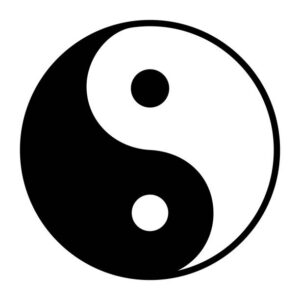Going Round

Ying yang symbol of harmony and balance
One of the things we humans do best is to sort our experiences into categories. Unlike other creatures, who seem to live in a seamless world of moment-to-moment events, our species has the capacity and evidently the obsession to pass judgment upon each and every thing that befalls us.
We accomplish this by first dividing the continuum of experience into its extremes and then giving those extremes labels. We divide temperatures into hot or cold, the twenty-four hour rotation of the earth into day and night, the density of materials into hard and soft. The result of all this division is known philosophically as the pairs of opposites.
Having established these pairs, we then tend to think in terms of them. Old and young, difficult and easy, naughty and nice, good and bad; little by little we make our worlds manageable by giving labels to our experiences. All of this is innocent enough and is usually learned in infancy along with mastery of the language. Together with such categories as past and future, living or dead, and up and down, we pick up notions of pleasure and pain, stupid and bright, and right or wrong.
What we usually fail to notice as we’re learning the pairs of opposites is that each side of each pair makes sense only in terms of the other side. The softness of a baby’s blanket is definable only by comparing it with something hard, like the headboard of its crib. And in between the two extremes there are countless materials of varying consistency that fit neither extreme, such as the mattress, a stuffed Teddy bear, and a squeaky rubber toy. Failing to see this mutual dependency between opposites and the many intermediates that link them leads us into autocratic patterns of thought, best known as “thinking in terms of black and white.”
Thinking this way can dupe us into believing that each side of each pair is forever separated from its opposite. In fact, each side not only depends on the other for definition, but tends toward becoming the other. Night moves steadily toward day, and day toward night. If we head north toward the pole we eventually pass it and find ourselves heading south. Each of us moves from birth toward death, after which our component atoms are recycled for more life, living toward dead, and dead toward living. The universe is ultimately circular, not linear. Our lives move in loops, not straight lines.
Failing to honor the circularity of events and to keep a lively sense of their mutual interdependence leads to rigidity, disappointment, and a grim view of what befalls us. If our mental picture of life is distorted, our lives will invariably seem out of whack.
But a clearer view of things brings with it solace and delight. An awareness of the loopiness of life does much to temper our arrogance and keeps us from bogging down in sullen depression.
The next time something bad happens, keep an open mind. Odds are that it will lead on to unexpected good.


we miss your sister Beth hoping to enjoy your newsletter Kendall and Treava